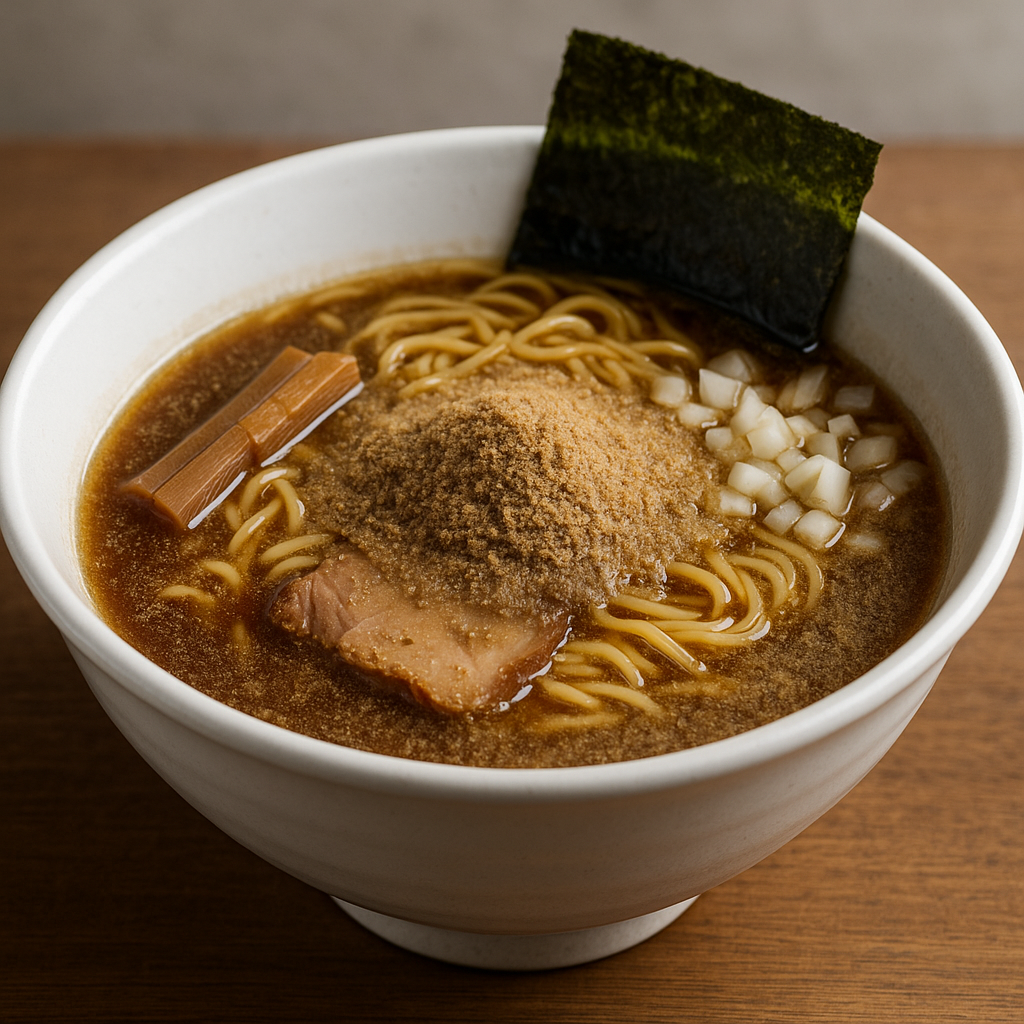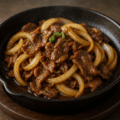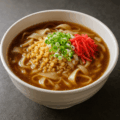煮干しラーメン(青森)の特徴
煮干しの濃密な旨みと香り
青森の煮干しラーメンは、煮干しの出汁を主役に据えた力強い味わい。澄んだ出汁から白濁寄りまで店舗ごとに個性があり、キレとコクの両立が魅力です。
低温抽出で苦味を抑える
頭と腹ワタを取り、沸騰させずに80〜90℃でじっくり抽出。えぐみを抑え、煮干し特有の香りを最大限に引き出します。
刻み玉ねぎが決め手
トッピングの刻み玉ねぎが清涼感と甘みを添え、濃い出汁でも後味はすっきり。中細〜中太麺との相性が抜群です。
煮干しラーメン(青森)のレシピ
材料(2人分)
- 中細〜中太麺 … 2玉
- 煮干し(頭と腹ワタを除く) … 40g
- 水 … 1,000ml
- 昆布 … 5×10cm 1枚
- (好みで)乾しいたけ … 1枚
- 長ねぎの青い部分 … 1本分(香味油用)
- サラダ油または米油 … 50ml(香味油用)
- 刻み玉ねぎ … 1/4個分(仕上げ)
- チャーシュー・メンマ・青ねぎ・焼き海苔 … 適量
かえし(煮切り)
- 濃口醤油 … 大さじ3
- 薄口醤油 … 大さじ1
- みりん … 大さじ1
- 酒 … 大さじ1
- 砂糖 … 小さじ1/2(お好みで)
作り方
- 下ごしらえ:煮干しは頭と腹ワタを外す。鍋に水・昆布・(あれば)干しいたけ・煮干しを入れ、30分浸す。
- スープ:弱めの火にかけ、80〜90℃を保って20〜25分抽出(沸騰させない)。火を止めて5分置き、濾す。
- かえし:小鍋でみりんと酒を一度沸かしてアルコールを飛ばし、醤油・砂糖を加えて火を止める。
- 香味油:小鍋に油と長ねぎの青い部分を入れ、弱火で10分じっくり加熱して香りを移す。ねぎを除く。
- 仕上げ:丼にかえし各大さじ2〜3、香味油小さじ1〜2を入れる。熱々のスープを300〜350ml注いで混ぜ、茹で上げた麺を入れる。チャーシュー、メンマ、刻み玉ねぎ、青ねぎ、海苔をのせる。
シェフのワンポイントアドバイス
苦味が出る時は「低温+短時間」を徹底し、煮干しは新鮮で油焼けのないものを使用。
塩分はかえし量で微調整し、玉ねぎは水に軽くさらして辛味を抜くと全体のバランスが整います。
煮干しの腸を敢えて取らずに、苦味を出す通向けの作り方もあり、癖になる味わいは本格的です。
栄養価(1杯の目安)
- エネルギー:約500〜650 kcal
- たんぱく質:20〜30 g
- 脂質:12〜22 g(香味油・チャーシュー由来で変動)
- 炭水化物:70〜85 g(麺由来)
- DHA・EPA(煮干し由来)/ヨウ素(昆布由来)
香味油の量でカロリーと風味の調整が可能。玉ねぎを増やすと食感と満足感が上がります。
歴史
家庭の出汁文化から生まれた一杯
煮干し出汁が根づく地域性を背景に、ラーメンへ応用して独自に発展。素材感の強い旨みが特徴です。
店ごとの個性が光る青森の味
澄んだ清湯から濃厚系まで幅があり、麺やタレ、香味油の組み合わせで多彩な表情を見せます。刻み玉ねぎのトッピングは定番として親しまれています。
English Version
Features of Niboshi Ramen (Aomori)
Intense Umami and Aroma from Dried Sardines
Aomori’s niboshi ramen centers the broth on dried sardines. Styles range from clear to slightly cloudy depending on the shop, striking a balance of clean “snap” and deep body.
Low-Temperature Extraction to Minimize Bitterness
Remove heads and innards, then steep at 80–90°C without boiling to curb harsh notes and draw out the signature niboshi fragrance to its fullest.
Chopped Onion Seals the Finish
A topping of finely chopped onion adds freshness and gentle sweetness, keeping the aftertaste crisp even with a robust broth. It pairs beautifully with medium-thin to medium-thick noodles.
Recipe
Ingredients (serves 2)
- Medium-thin to medium-thick ramen noodles … 2 portions
- Dried sardines (heads & innards removed) … 40 g
- Water … 1,000 ml
- Kombu … 1 sheet (5 × 10 cm)
- (Optional) Dried shiitake … 1 piece
- Green part of a leek … from 1 stalk (for aroma oil)
- Neutral oil or rice oil … 50 ml (for aroma oil)
- Chopped onion … from 1/4 onion (for topping)
- Chashu, menma, sliced scallion, roasted nori … to taste
Kaeshi (seasoning base; with nikiri)
- Dark soy sauce … 3 tbsp
- Light soy sauce … 1 tbsp
- Mirin … 1 tbsp
- Sake … 1 tbsp
- Sugar … 1/2 tsp (optional)
Instructions
- Prep: Remove heads and innards from the niboshi. In a pot, combine water, kombu, (optional) dried shiitake, and niboshi; soak 30 minutes.
- Broth: Heat gently and hold at 80–90°C for 20–25 minutes without boiling. Turn off the heat, rest 5 minutes, then strain.
- Kaeshi: Bring mirin and sake just to a boil to evaporate alcohol (nikiri). Remove from heat; add soy sauces and sugar.
- Aroma oil: Warm oil with the leek greens over low heat for about 10 minutes to infuse; remove the leek.
- Assemble: In each bowl, add 2–3 tbsp kaeshi and 1–2 tsp aroma oil. Pour in 300–350 ml hot broth and mix. Add cooked noodles and top with chashu, menma, chopped onion, scallion, and nori.
Chef’s Tip
If bitterness creeps in, keep extraction low-temp and brief, and use fresh, non-rancid niboshi. Adjust saltiness via the kaeshi. Lightly rinse chopped onions to mellow sharpness and balance the bowl. For connoisseurs seeking a pronounced bitterness, some recipes intentionally leave the innards intact—an assertive, acquired profile.
Nutritional Value (per bowl, approx.)
- Calories: 500–650 kcal
- Protein: 20–30 g
- Fat: 12–22 g (varies with aroma oil and chashu)
- Carbohydrates: 70–85 g (from noodles)
- DHA & EPA (from niboshi) / Iodine (from kombu)
Adjust aroma oil to fine-tune calories and richness. Extra onion boosts texture and satisfaction.
History
Born from a Home Broth Culture
Rooted in a regional tradition of niboshi stock, the technique was adapted to ramen and evolved locally, prized for its ingredient-forward umami.
Aomori’s Shop-by-Shop Personality
From clear, refined broths to dense, punchy styles, combinations of noodles, kaeshi, and aroma oil vary widely. Chopped onion has become a beloved signature topping.



何でも質問してください!